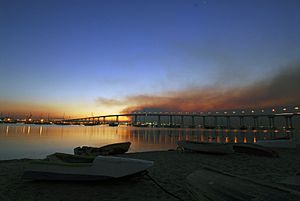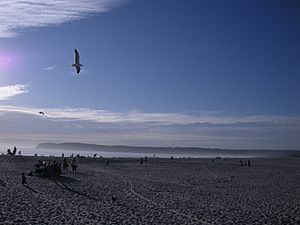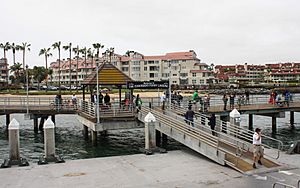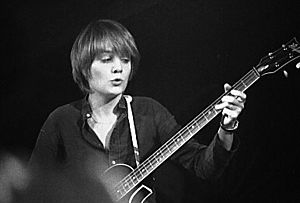Coronado, California facts for kids
Quick facts for kids
Coronado, California
|
|||
|---|---|---|---|
| City of Coronado | |||
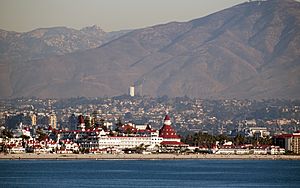
The Hotel del Coronado in December 2008
|
|||
|
|||
| Nickname(s):
"The Crown City"
|
|||
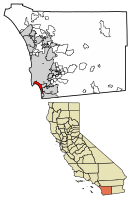
Location of Coronado in San Diego County, California
|
|||
| Country | |||
| State | |||
| County | |||
| Incorporated | December 11, 1890 | ||
| Government | |||
| • Type | Mayor-council | ||
| Area | |||
| • Total | 32.50 sq mi (84.17 km2) | ||
| • Land | 7.80 sq mi (20.22 km2) | ||
| • Water | 24.69 sq mi (63.96 km2) 75.72% | ||
| Elevation | 16 ft (5 m) | ||
| Population
(2020)
|
|||
| • Total | 20,192 | ||
| • Density | 2,587.06/sq mi (998.82/km2) | ||
| Time zone | UTC-8 (Pacific) | ||
| • Summer (DST) | UTC-7 (PDT) | ||
| ZIP codes |
92118, 92178
|
||
| Area code | 619 | ||
| FIPS code | 06-16378 | ||
| GNIS feature IDs | 1660513, 2410233 | ||
Coronado (Spanish for "Crowned") is a resort city located in San Diego County, California, United States, across the San Diego Bay from downtown San Diego. It was founded in the 1880s and incorporated in 1890. Its population was 24,697 at the 2010 census, up from 24,100 at the 2000 census.
Coronado is a tied island which is connected to the mainland by a tombolo (a sandy isthmus) called the Silver Strand. The explorer Sebastian Vizcaino gave Coronado its name and drew its first map in 1602. Coronado is Spanish term for "crowned" and thus it is nicknamed The Crown City. Its name is derived from the Coronado Islands, an offshore Mexican archipelago. Three ships of the United States Navy have been named after the city, including USS Coronado.
Contents
History
Coronado was incorporated as a town on December 11, 1890. The land was purchased by Elisha Spurr Babcock, along with Hampton L. Story, and Jacob Gruendike. Their intention was to create a resort community, and in 1886, the Coronado Beach Company was organized. By 1888, they had built the Hotel del Coronado, and the city became a major resort destination. They also built a schoolhouse, and formed athletic, boating, and baseball clubs.
In 1900, a tourist/vacation area just south of the Hotel del Coronado was established by John D. Spreckels and named Tent City. Over the years the tents gave way to cottages, the last of which was torn down in late 1940 or early 1941.
In the 1910s, Coronado was connected to San Diego by the Class 1 streetcars and an extensive, accompanying San Diego public transit system that was spurred by the Panama–California Exposition of 1915 and built by John D. Spreckels. These streetcars became a fixture of the city until their retirement in 1939.
Geography
According to the United States Census Bureau, the city has a total area of 32.7 square miles (85 km2); 20.5 km² (7.9 mi²) of the city is land and 24.7 square miles (64 km2) of it (75.72%) is water.
Geographically, Cornado is not an "island". It is a tied island, connected to the mainland by a strip of land called the Silver Strand. This tombolo, along with Coronado and North Island, forms San Diego Bay. Originally, Coronado was mostly separated from North Island by a shallow inlet of water called the Spanish Bight, but just like Coronado, North Island was never completely surrounded by water. The development of North Island by the United States Navy prior to and during World War II led to the filling of the bight by July 1944, combining the land areas into a single body. The Navy still operates Naval Air Station North Island (NASNI or "North Island") on Coronado. On the southern side of the town is Naval Amphibious Base Coronado, a training center for Navy SEALs and Special warfare combatant-craft crewmen (SWCC). Both facilities are part of the larger Naval Base Coronado complex. Though there has been localized development of the coastline, including some minor landfill, Coronado retains largely the same area that it had in 1857.
On New Year's Day 1937, during the Great Depression, the gambling ship SS Monte Carlo, known for "drinks, dice, and dolls", was shipwrecked on the beach about a quarter mile south of the Hotel del Coronado.
In 1969, the San Diego–Coronado Bridge was opened, allowing much faster transit between the cities than bay ferries or driving via State Route 75 along the Silver Strand. The city is currently weighing the options of additional construction on Highway 75 to alleviate congestion as traffic flows to and from San Diego and North Island.
Climate
According to the Köppen climate classification system, Coronado has a semi-arid climate, abbreviated "BSk" on climate maps.
Demographics
| Historical population | |||
|---|---|---|---|
| Census | Pop. | %± | |
| 1860 | 276 | — | |
| 1870 | 229 | −17.0% | |
| 1900 | 935 | — | |
| 1910 | 1,477 | 58.0% | |
| 1920 | 3,289 | 122.7% | |
| 1930 | 5,425 | 64.9% | |
| 1940 | 6,932 | 27.8% | |
| 1950 | 12,700 | 83.2% | |
| 1960 | 18,039 | 42.0% | |
| 1970 | 20,020 | 11.0% | |
| 1980 | 18,790 | −6.1% | |
| 1990 | 26,540 | 41.2% | |
| 2000 | 24,100 | −9.2% | |
| 2010 | 24,697 | 2.5% | |
| 2020 | 20,192 | −18.2% | |
| U.S. Decennial Census | |||
2010
The 2010 United States Census reported that the City of Coronado had a population of 24,697. The racial makeup of Coronado was 20,074 (81.2%) White, 1,678 (6.8%) African American, 201 (0.8%) Native American, 925 (3.7%) Asian, 101 (0.4%) Pacific Islander, 762 (3.1%) from other races, and 956 (3.9%) from two or more races. Hispanic or Latino of any race were 3,354 persons (13.6%).
2000
As of the 2000 census, there were 24,100 people, 7,734 households, and 4,934 families residing in the city. The population density was 3,121.9 inhabitants per square mile (1,205.3/km2). There were 9,494 housing units at an average density of 1,229.8 per square mile (474.8/km2). The racial makeup of the city was 84.40% White, 5.15% African American, 0.66% Native American, 3.72% Asian, 0.30% Pacific Islander, 3.14% from other races, and 2.63% from two or more races. Hispanic or Latino of any race were 9.83% of the population.
There were 7,734 households, out of which 27.0% had children under the age of 18 living with them, 54.0% were married couples living together, 7.4% had a female householder with no husband present, and 36.2% were non-families. 30.9% of all households were made up of individuals, and 13.3% had someone living alone who was 65 years of age or older. The average household size was 2.27 and the average family size was 2.84.
In the city, the population was spread out, with 16.0% under the age of 18, 20.2% from 18 to 24, 29.3% from 25 to 44, 18.7% from 45 to 64, and 15.8% who were 65 years of age or older. The median age was 34 years. For every 100 females, there were 139.8 males. For every 100 females age 18 and over, there were 149.1 males.
48.2% of those age 25 and over have a bachelor's degree or higher. According to a 2007 estimate, the median income for a household in the city was $91,748, and the median income for a family was $119,205.
Real estate in the city of Coronado is very expensive. According to a recent county-wide ZIP code chart published in The San Diego Union-Tribune in August 2006, the median cost of a single-family home within the city's ZIP code of 92118 was $1,605,000. In 2010, Forbes.com found that the median home price in Coronado had risen to $1,840,665.
Tourism
Tourism is an essential component of Coronado's economy. This city is home to three major resorts (Hotel del Coronado, Coronado Island Marriott and Loews Coronado Bay Resort) as well as several other hotels and inns. The downtown district along Orange Avenue with its many shops, restaurants and theaters is also a key part of the local economy. Many of the restaurants are highly rated and provide a wide variety of cuisine choices.
In 2008, the Travel Channel rated Coronado Beach as the fifth best beach in America.
Economy
Top employers

According to the city's 2012 Comprehensive Annual Financial Report, the top 10 employers in the city are:
| # | Employer | # of Employees |
|---|---|---|
| 1 | United States Navy (Naval Air Station North Island, et al.) | 11,000–14,999 |
| 2 | Hotel del Coronado | 1,000–4,999 |
| 3 | Loews Coronado Bay Resort | 500–999 |
| 4 | Sharp Coronado Hospital | 500–999 |
| 5 | City of Coronado | 250–499 |
| 6 | Coronado Unified School District | 250–600 |
| 7 | Coronado Island Marriott Resort | 250–499 |
| 8 | BAE Systems | 100–249 |
| 9 | Peohe's | 100–249 |
| 10 | Realty Executives Dillon | 50–99 |
Notable people
- Lisa Bruce – film producer
- Johnny Downs – child actor who played "Johnny" in the Our Gang series of short films from 1923 to 1926
- Lloyd Haynes – actor and television writer, known for TV series Room 222
- Mary Beardslee Hinds - American First Lady of Guam.
- Mae Hotely – silent film actress who appeared in 85 films between 1911 and 1929
- Jim Kelly – martial artist and actor, starred in Enter the Dragon with Bruce Lee
- Genai Kerr - U.S. Water Polo Olympian and NCAA All-American
- Anita Page – silent film actress
- Sarah Roemer – actress and model, starred in 2007's Disturbia with Shia LaBeouf
- Rodney Scott – Chief of United States Border Patrol
- Tim Thomerson – actor and comedian, known for his portrayal of Jack Deth in the Trancers film series
- Wende Wagner – actress
- William Witney – film director
Music
- Kevin Kenner – concert pianist
- Mojo Nixon – musician and radio host
- Nick Reynolds – founding member of The Kingston Trio
- George Sanger – video game music composer
- Paul Sykes – singer
- Scott Weiland – former lead singer of Stone Temple Pilots and Velvet Revolver.
- Tina Weymouth – bassist and vocalist of Talking Heads and Tom Tom Club
Commerce
- Charles T. Hinde – riverboat captain, businessman, original investor in Hotel del Coronado
- Doug Manchester – real estate developer and publisher of San Diego Union Tribune
- Orville Redenbacher – businessman behind eponymous brand of popcorn
- John D. Spreckels – transportation and real estate mogul
- Jonah Shacknai – (CEO of Medicis Pharmaceutical) and his girlfriend Rebecca Zahau
- Ira C. Copley – publisher, politician, and utility tycoon
Military
Army
- Townsend Griffiss, first American airman killed in Europe following the United States's entry into World War II
Marine Corps
- General Joseph Henry Pendleton, USMC – Mayor of Coronado from 1928 to 1930, namesake of Camp Pendleton
- Major General John H. Russell Jr., USMC – 16th Commandant of the Marine Corps, son of Rear Admiral John Henry Russell, USN and father of Brooke Astor, noted philanthropist.
- Captain Ward Boston, USN – World War II Navy fighter pilot, then attorney for the Naval Board of Review which investigated the 1967 USS Liberty Incident
- Admiral Charles K. Duncan – USN Supreme Allied Commander Atlantic
- Admiral Leon A. Edney – USN
- Admiral Thomas B. Fargo, USN – inspiration for fictional Captain Bart Mancuso in film The Hunt for Red October
- Alfred Walton Hinds - Naval officer and Governor of Guam.
- John S. McCain Sr. – grandfather of Arizona senator and U.S. presidential candidate John McCain
- Admiral George Stephen Morrison, USN – father of The Doors' lead singer, Jim Morrison
- Commander Alan G. Poindexter, USN – NASA astronaut and Navy test pilot
- Rear Admiral Uriel Sebree, USN – made two Arctic expeditions, was the second acting governor of American Samoa, and served as commander-in-chief of the Pacific Fleet
- Commander Earl Winfield Spencer Jr., USN – first commanding officer of Naval Air Station San Diego
- Vice Admiral James Stockdale, USN – Medal of Honor recipient and 1992 candidate for vice president with Ross Perot
Sports
- Layne Beaubien – 2008 Olympic silver medalist in water polo
- Cam Cameron – offensive coordinator for NFL's Baltimore Ravens, San Diego Chargers
- Chad Fox – Major League baseball pitcher for several teams, including Florida Marlins 2003 World Series championship team
- Ken Huff—former NFL player
- Fulton Kuykendall – former NFL player
- Jim Laslavic – former NFL linebacker
- Gene Rock – former professional basketball player
- Sven Salumaa – former professional tennis player
- William Thayer Tutt – past president of International Ice Hockey Federation, member of Hockey Hall of Fame
- Don Orsillo – play-by-play announcer for the San Diego Padres
Writers and poets
- L. Frank Baum – author of The Wizard of Oz, which in part was written while he resided on Coronado.
- Landis Everson – poet
Images for kids
See also
 In Spanish: Coronado (California) para niños
In Spanish: Coronado (California) para niños





